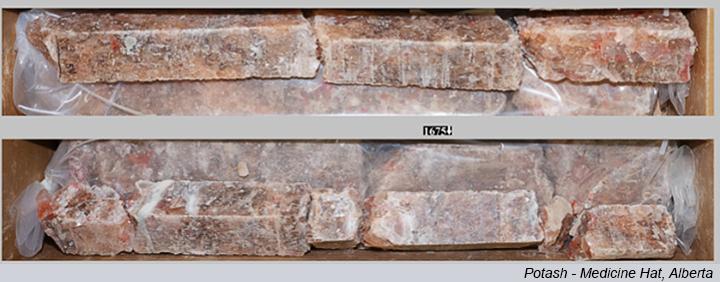Critical Minerals in Alberta
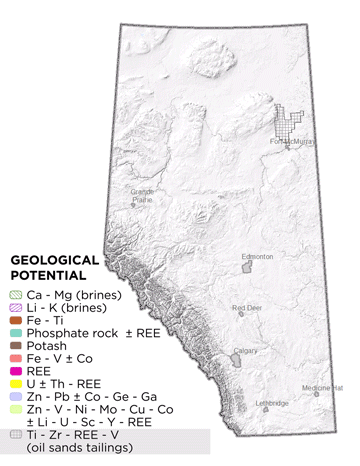
Critical minerals are the minerals essential for sustainable economic success, economic security, the energy transition, and a reliable resource supply chain. Alberta has potential for many of these minerals and as of 2022, there are several exploration projects focused on discovering critical mineral deposits in the province. Since 2016, industry has focused a lot of attention on discovering lithium and helium potential due to an increased global demand for these minerals and because they are commonly found in oil and gas fields in Alberta. However, lithium and helium are not the only critical minerals that have the potential for production in Alberta. Other critical minerals of interest in Alberta include, but are not limited to, uranium, potash, and vanadium.
Critical Minerals Potential
Critical minerals are defined as minerals essential for sustainable economic success, economic security, the energy transition, and a reliable resource supply chain. Together, the federal, provincial, and territorial governments, and industry created the 2021 list of Canadian critical minerals.
Canada's 2021 List of 31 Critical Minerals
| Aluminum | Gallium | Molybdenum | Tellurium |
| Antimony | Germanium | Nickel | Tin |
| Bismuth | Graphite | Niobium | Titanium |
| Cesium | Helium | Platinum group metals | Tungsten |
| Chromium | Indium | Potash | Uranium |
| Cobalt | Lithium | Rare earth elements | Vanadium |
| Copper | Magnesium | Scandium | Zinc |
| Fluorspar | Manganese | Tantalum |
Learn More About:
Critical minerals can be produced as a primary commodity or a by-product of a non-critical mineral deposit. Alberta has potential for critical minerals that sometimes accompany a primary economic mineral considered as non-critical. For example, vanadium or titanium may occur in a primary iron deposit and rare earth elements may occur in phosphate deposits.
| Critical Mineral | Symbol | Some Uses |
|---|---|---|
| Cobalt | Co | Rechargeable batteries |
| Copper | Cu | Electrical wires and metal alloys |
| Gallium | Ga | LEDs and integrated circuits |
| Germanium | Ge | Fibre optics and night vision |
| Lithium | Li | Rechargeable batteries |
| Magnesium | Mg | Steel, ceramics, and furnace linings |
| Molybdenum | Mo | Steel alloys |
| Nickel | Ni | Stainless steel, batteries, and coins |
| Potash | K | Fertilizer |
| Rare earth elements | REE | Permanent magnets and LCD screens for electronics |
| Scandium | Sc | Fuel cells |
| Titanium | Ti | White pigments and metal alloys |
| Uranium | U | Nuclear fuel |
| Vanadium | V | Metal alloys and grid batteries |
| Zinc | Zn | Galvanized steel, die-castings and metal alloys |
| Zirconium | Zr | High temperature ceramics |
| Non-critical Mineral | Symbol | Some Uses |
|---|---|---|
| Calcium | Ca | Calcium chloride to make de-icing products |
| Lead | Pb | Car batteries, pigments, and weights |
| Iron | Fe | Alloy steels |
| Phosphate (sedimentary) | P | Fertilizer |
Lithium is a highly reactive metal with widespread uses, particularly in rechargeable batteries for phones, electric cars, and energy storage. Other uses include in additives in glass and ceramic, lubricant, and pharmaceutical manufacturing. In Alberta, lithium is found dissolved in deep formation waters and in oil- and gas-field brines, which is groundwater coexisting with oil and gas and contains large amounts of dissolved compounds and elements. This lithium-rich water comes to the surface during oil production and is usually reinjected into deep geological units after removing the oil and/or gas. However, there is interest now in processing these brines to extract the lithium and other valuable metals (e.g., potassium, magnesium, and calcium) before reinjecting the remaining brine back into the ground.
In 2010, we found oil-field brines with elevated lithium concentrations in Devonian strata in two areas: west-central Alberta near Grande Prairie and central Alberta near Red Deer.
Learn More About:
- Lithium-rich Formation Water
- Li-enrichment of Oilfield Brines
- Lithium Content Groundwater and Formation Water
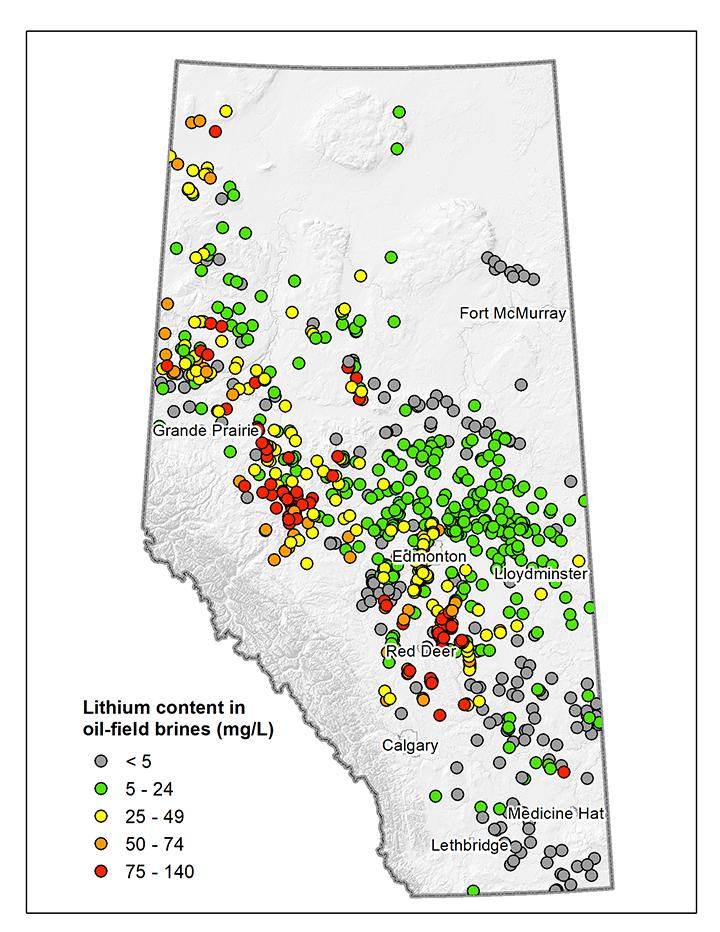
Although helium is not technically a mineral resource, it is included on Canada's critical minerals list. Helium is a nonreactive gas used for supercooling (such as in magnetic resonance imaging [MRI] machines) and as an inert gas in industrial processes. Some natural gas contains low concentrations of helium. Normally during natural gas production, operators remove helium and other gases as waste to produce natural gas, however, in some cases the helium concentration is high enough to economically extract it as product.
The oil and gas industry routinely tests constituent gases in wells and submits these results to the Alberta Energy Regulator. In 2021, we reviewed these data, and they show the greatest helium concentrations in
- Devonian strata in west-central Alberta,
- Cretaceous strata in southern Alberta,
- Cretaceous strata in east-central Alberta (to a lesser extent), and
- Cambrian strata in southern Alberta (based on limited samples and correlations to similar strata in Saskatchewan).
Learn More About:
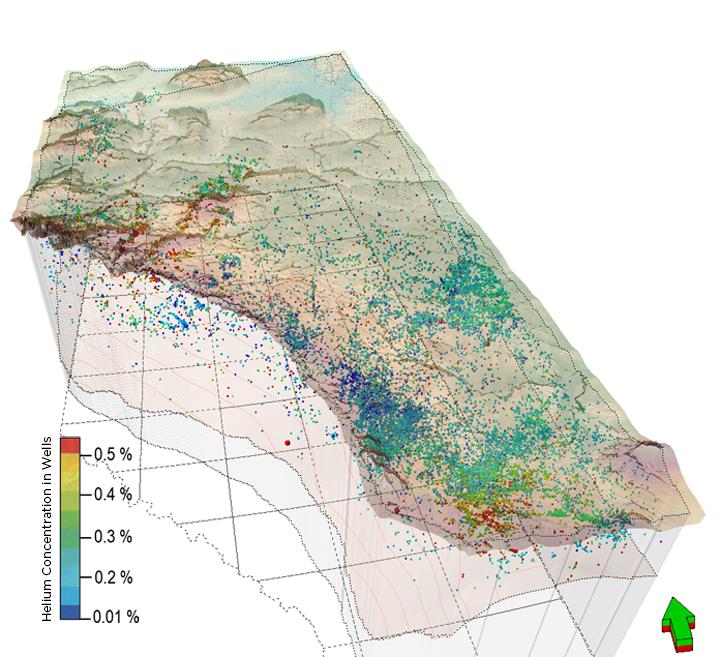
Uranium is found in three deposit types in Alberta: unconformity related, pegmatite hosted, and sandstone hosted. Of these three deposit types, the unconformity-related uranium deposits, particularly in the Athabasca Basin in northeastern Alberta, show the most potential for future development. This potential is exemplified by the world-class uranium mines in the Athabasca Basin in neighbouring northwestern Saskatchewan, increasing the probability of finding similar deposits in Alberta. The Maybelle structural trend, south of Lake Athabasca, is of particular interest in the northeastern Alberta portion of this basin. Along this trend, steep fractures in sandstone contain disseminated (i.e., scattered) to massive high-grade uraninite at the base of the Fair Point Formation of the Athabasca Group. Between 1988 and 2003, exploration companies drilling in this area intersected intervals containing significant triuranium octoxide (U3O8) values, with one instance reporting 21% U3O8 over 5 metres including 54.85% U3O8 over 50 centimetres. Beyond the Maybelle structural trend, uranium mineralization potential also exists along the northern rim of the Athabasca Basin.
Learn More About:
- Uranium exploration in the western Athabasca Basin
- Uranium mineralization in the Athabasca Group
- Geology of the Athabasca Group
- Uranium and the northern rim of the Athabasca Basin
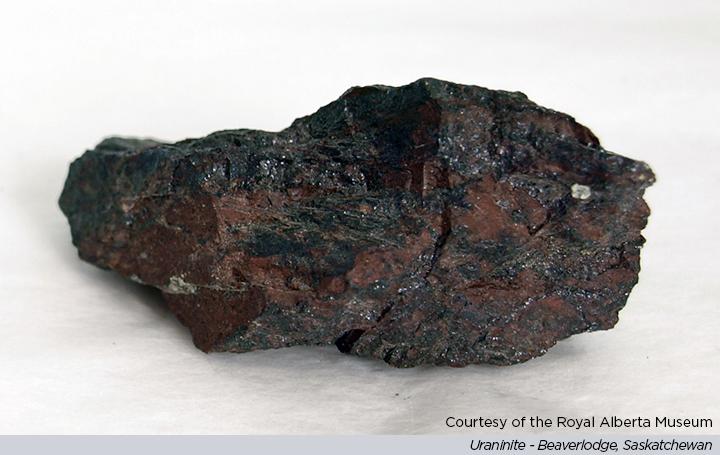
In Alberta, metalliferous black shales potentially contain recoverable quantities of critical minerals, particularly zinc, nickel, and vanadium. Near-surface units of the Exshaw, Second White Specks, and Loon River formations are considered highly metalliferous and can also show enrichment in other critical minerals such as cobalt, rare-earth elements, and uranium.
Access the Data:
- Geochemistry of sedimentary units of the Western Canada Sedimentary Basin part 1
- Geochemistry of sedimentary units of the Western Canada Sedimentary Basin part 2
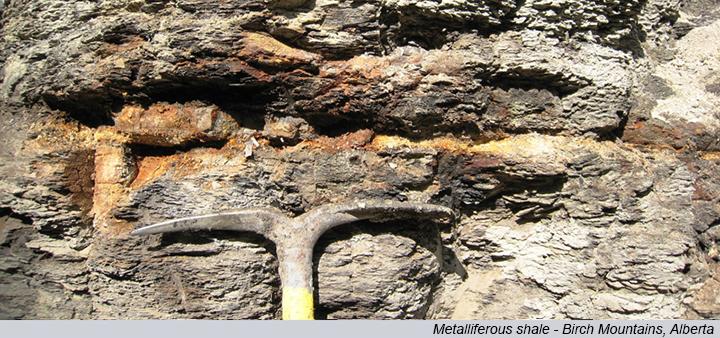
Other significant critical mineral resources in Alberta include potash, vanadium, and rare-earth elements. Potash potential exists in the uppermost Prairie Evaporite Formation along our southeastern border with Saskatchewan. Vanadium occurs in the Clear Hills ironstone deposit in northwestern Alberta, in highly metalliferous black shales, and in oil sands bitumen and petroleum coke (petcoke) stockpiles. Potential for rare-earth elements exists in a wide range of geological environments. Sedimentary phosphate, highly metalliferous black shales, and granitic pegmatites contain interesting concentrations. Rare-earth elements also concentrate in wastes from oil sands processing.
Learn More About:
